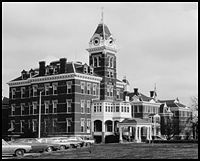Main Page
__NOTITLE__
|
We need your help!
|
| Overview · Editing · Help · How To Upload Images |
|
Both the Fergus Falls and Athens Kirkbride buildings are in danger of being partially or completely demolished. Please click on the link above for more information and to see how you can help.
|
Mission Statement
The Mission
The mission of this site is to archive both historical and current information on asylums across the United States and around the world.
The Statement
This site is dedicated to the history of asylums in all forms. The term of asylum is applied to not only what is commonly thought of: mental hospitals, but can also be applied to sanatoriums, state training schools, reform schools, almshouses, and orphanages. These institutions have and continue to play a major part in today's society.
Everyone throughout the United States and in many other countries has in one way or another felt the touch of these institutions. These places have both directly and indirectly affected people and their families. They have shaped lives and created many popular myths about them.
With all that in mind, this site was created to help in the historical research of any institutions that can be classified as an asylum. It was created for both serious researchers, those who are doing genealogical research, and people with an interest in asylums.
Featured Article Of The WeekAthens State HospitalIn 1867 the Ohio Legislature appointed a commission to find a site for an asylum in south-eastern Ohio. A site in Athens was found suitable. Construction began in 1867 and the Athens Lunatic Asylum was completed during 1874. Levi T. Scofield was the architect. The Athens Mental Health Center opened on January 9, 1874 on land purchased from the Coate's farm. The asylum itself was built from bricks which were fired on-site from clay dug on-site. Herman Haerlin, a student of Frederick Law Olmstead (the designer of Central Park), was responsible for the design of the hospital and its grounds. By the turn of the twentieth century, orchards and farmland were maintained on the property, tended to by hospital residents and employees. This made the hospital nearly self-sufficient. Nevertheless, at the time of its construction it was a major boon to the economy of the city of Athens, which was able to supply milk, eggs, linens, and other necessities. Local citizens made use of Haerlin's extensive grounds, which included landscaped hills and trees, a pond, a spring, and a creek with a falls. Click here for more... Featured Image Of The WeekThe Cleveland State Hospital was a state-supported psychiatric facility for long-term care. Originally known as the Northern Ohio Lunatic Asylum, it was the second of 6 public asylums established in Ohio during the 1850s. It was later known as Newburgh State Hospital. The Northern Ohio Lunatic Asylum was authorized by an act of the Ohio legislature. The main building, containing 100 beds, was completed in 1855 on land in Newburgh donated by the family of James A. Garfield, later U.S. president. Previously, many of those considered insane had been kept in jails or almshouses.
|
Recent Message Board PostsHello,
In this space you normally would see our forum. This had been a hold over from earlier days before we had a Facebook page. Just prior to our server issues regular users had been barely using the forum with the majority of new posts from anonymous users asking genealogy questions or spammers. The old forum software does not work with our new version while the new forum software does not carry over old comments to the new forum. As a result, the forum will be discontinued in favor of our Facebook page. If you have questions or comments you can ask them there. Featured Video |
Upcoming Events Calendar
<calendar name="Upcoming Events" disablestyles disableaddevent/>
Asylum News (news you can edit!)
February 7, 2016 Clarinda struggles to fill former hospital
- The 128-year-old former mental health institute in the small southwest Iowa city of Clarinda isn’t your typical real estate opportunity, and so far no one is rushing to move in. More than seven months after the state closed the Clarinda Mental Health Institute, much of the sprawling building remains empty, including entire floors that haven’t been used in decades.
February 1, 2016 Efforts continue to preserve other parts of former Peoria State Hospital grounds
- Christina Morris happily remembers Sunday morning breakfasts with her grandparents, followed by visits to the peaceful cemeteries on the grounds of the Peoria State Hospital, where some family members are buried. “My interest with the state hospital started when I was about 7 years old,” Morris said in a recent interview. “When I would come onto the grounds (my grandfather) would say that this was a place of special people. (By special) I thought he meant giants, because these buildings were so big and beautiful and immaculate to me. I just was enamored by how beautiful it was.”
January 7, 2016 That Time The United States Sterilized 60,000 Of Its Citizens
- Not too long ago, more than 60,000 people were sterilized in the United States based on eugenic laws. Most of these operations were performed before the 1960s in institutions for the so-called “mentally ill” or “mentally deficient.” In the early 20th century across the country, medical superintendents, legislators, and social reformers affiliated with an emerging eugenics movement joined forces to put sterilization laws on the books.
January, 6, 2016 Pa. hires firm to develop plan for Harrisburg State Hospital site
- Harrisburg, PA-The state has hired a Lancaster planning company to help it figure out what to do with the former Harrisburg State Hospital, which closed 10 years ago. Since closing in 2006, the hospital complex has housed state workers from the state police, Department of General Services and the Department of Human Services. It is now part of the larger DGS Annex property, which encompasses 303 acres across Harrisburg and Susquehanna Township.


